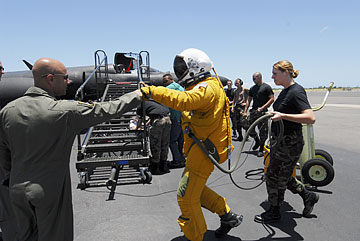High spying planes stop at Hickam
U-2 pilots sing the praises of their "Dragon Lady" on a refueling stop at Hickam
FLYING at an altitude of more than 70,000 feet, an Air Force U-2 spy plane pilot says there are times "you can actually see the sunset twice."
U-2S 'DRAGON LADY'
Primary function: High-altitude reconnaissance
Thrust: 17,000 pounds
Length: 63 feet
Height: 16 feet
Wingspan: 105 feet
Speed: 410+ mph
Range: 7,000+ miles
Ceiling: Above 70,000 feet
Crew: One
First deployed: August 1955
Cost: Classified
Inventory: Active force, 36; Reserve, 0; ANG, 0
Source: U.S. Air Force
|
"That is because you are so high, you can actually see the curvature of the Earth. The color of the sky is purple," said Capt. Ralph Shovkry, who has been piloting the "Dragon Lady" spy plane for nearly four years.
"Even after taking off after sunset, you will be able to see the sun set again, and the moon rise. It is very awesome."
At that altitude, U-2 pilots have to wear pressurized suits costing $250,000 each, similar to those used by astronauts.
Blood boils at 60,000 feet, so controlling the environment for U-2 pilots is critical. Each pilot, like Capt. Gregory Hafner, is hooked up to portable oxygen and a coolant system.
Yesterday Hafner piloted one of three U-2 "Dragon Lady" spy planes that made a half-day refueling stop at Hickam Air Force on their way to Osan Air Base in South Korea.
Home for the 36 Air Force spy planes is the 9th Reconnaissance Wing at Beale Air Force Base near Sacramento, Calif. Because the spy planes cannot be refueled in the air, they had to stop here before flying the last 4,000-mile leg to South Korea nonstop.
Shovkry, 35, said U-2 spy planes have been used in every mission during the war on terrorism, providing intelligence during operations in Korea, the Balkans, Afghanistan and Iraq. "Everyone wants them," he said.
The Air Force says the spy plane can transmit a variety of intelligence products, except film, in real time anywhere in the world, using satellite links.
Members of Shovkry's unit, the 99th Reconnaissance Squadron, can expect to fly at least two missions a year, averaging anywhere from 120 to 150 days.
The U-2 spy plane flew its first mission in 1955. Its most infamous flight occurred in 1960, when pilot Francis Gary Powers was shot down and held by the Soviet Union for nearly two years until he was exchanged for a Soviet spy being held by the United States.

GREGG KAKESAKO / GKAKESAKO@STARBULLETIN.COM
Capt. Gregory Hafner, right, greeted Capt. Ralph Shovkry before strapping in for a nonstop 10-hour flight to Korea.
|
|
On Oct. 14, 1962, a U-2 photographed the Soviets installing missiles on Cuba.
But Shovkry said the spy planes also support humanitarian missions.
"With only a few days' warning," he said, "U-2s mapped the entire impact area caused by Hurricane Katrina in only one day."
Shovkry said the most difficult procedure is landing the 63-foot spy plane. "You have to land it on its bicycle-type tail landing wheels and nearly stall it to make the landing," he said.
He shrugs off talk of replacing U-2s with unmanned aerial vehicles, like the Predators now used in Iraq for surveillance.
"I think it's a bad deal," Shovkry said. "The benefit of a pilot in the cockpit outweighs remotely controlled vehicles."

